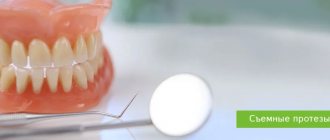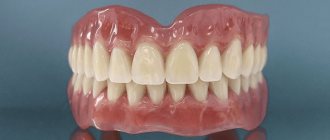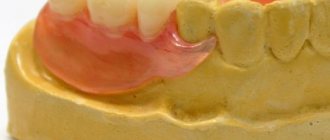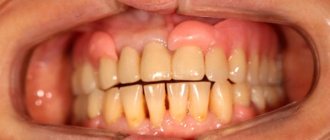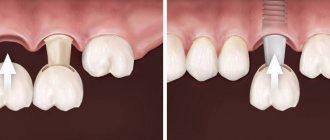How a partial denture is attached to the jaw
There are 3 options for fastening removable structures: hooks (clasps), locks (attachments), telescopic crowns.
We propose to consider each of the options in more detail. Clasps. They are hooks made of metal or plastic that grip healthy teeth and fix the orthopedic structure in the mouth. The disadvantage of such fastening is poor fixation and unsatisfactory aesthetics. Despite the fact that the hooks are covered by the lip, they are visible to others when smiling and talking.
Attachments. More preferable from an aesthetic point of view. The special lock consists of 2 parts. One element is built into the base of the prosthesis, and the other is attached to the crown that covers your own tooth. This fastening option has a more reliable fixation and gives the product stability. In addition, the attachments distribute the chewing load more evenly, which slows down bone atrophy by almost 2 times.
Telescopic crowns. Presented by a system consisting of 2 crowns. The inner one follows the contours of the ground tooth. The outer one is connected to the base and restores the shape of the tooth. This allows the prosthesis to be securely fixed and prevents it from moving. The possibility of installing a telescopic structure in each specific case is determined by the doctor, since grinding of a large layer of hard tissue of the supporting tooth is required.
What types of removable dentures are there?
Removable dentures are classified according to the material of manufacture, method of attachment and indications. In addition, they are:
- completely removable;
- partially removable;
- conditionally removable.
These varieties can be used as permanent or temporary, for example, in preparation for implantation.
Fully removable
This option is equally good for cases of partial and complete edentia. Such an orthodontic appliance consists of a base (plastic, acrylic, metal-plastic or nylon) on which the teeth (acrylic, nylon or polyurethane) are located. Two types are considered popular and best among analogues (according to a number of characteristics):
- Acrylic.
- Acrylic-free.
Both of them have a number of features and indications that you should familiarize yourself with before choosing the best option.
Acrylic
They represent a complete or partial imitation of the dental system (depending on the number of missing units). Indicated for prosthetics of both jaws. Considered a budget option.
| Advantages | Flaws |
|
|
In addition, patients who have installed such orthodontic products are strictly prohibited from eating sticky and hard foods, as they can damage and render the prosthesis unusable. It is also worth knowing that acrylic is an excellent environment for the development of bacteria. Irregular or careless care of such dentures can lead to allergies or bacterial contamination. At night, acrylic dentures must be removed and stored in special solutions.
Acrylic-free (AcryFree)
AcryFree is innovative and superior to other full dentures. They are elastic and flexible, but at the same time durable and provide the necessary rigidity during operation. The manufacturing material used is acrylic resin, the quality characteristics of which are several times higher than medical nylon and plastic.
| Advantages | Flaws |
|
|
The main distinguishing feature is the translucency of the prosthesis base. The biocompatibility of the material ensures hypoallergenicity. In addition, high aesthetics makes AcryFree invisible to others.
Completely removable dentures are made taking into account all the physiology of the patient’s oral cavity (after taking impressions).
Partially removable
Partially removable dentures include those that require some effort to remove. You can remove them from the oral cavity yourself, but you need to know how the structure chosen for prosthetics works - how it is attached. This type of orthodontic appliances includes the following:
- clasp;
- QuattroTi (Quadrotti);
- without sky.
Each type has its own characteristics and requires a more detailed consideration.
Clasp
A classic version of conditionally schematic prostheses. There are four types:
- On clasps
. The most budget option. The design contains claw-shaped hooks. The main nuance that can be considered a disadvantage is the visibility of the fixing elements when smiling. Such orthodontic devices are chosen by those who do not care about high aesthetics. - Telescopic
. This type is characterized by the presence of two telescopic crowns - internal (metal, covering the supporting teeth) and external (made of metal-ceramics or plastic), attached to the prosthesis. The peculiarity of this type of prosthetics is the need for depulpation and turning of supporting units. - On attachments (locks)
. It consists of two parts, the first is on the tooth, the second is in the prosthesis. The parts of such an orthodontic apparatus are connected using special locks. The result looks very aesthetically pleasing. The main disadvantages are that installation requires depulpation and strong turning of the supporting units. - Splinting
. It solves two problems at once - restores the dentition and prevents loosening of movable units. The peculiarity of the fastening is a hook-shaped shape that completely follows the shape of the tooth. This option is better than others for patients with diseases such as periodontitis, gingivitis and periodontal disease.
The design of the clasp prosthesis itself consists of the following parts:
- metal arc (clasp), which is a support;
- base - a base that imitates gums on which artificial teeth are mounted;
- teeth (or crowns) made of metal ceramics, zirconium or ceramics;
- fastenings
An orthopedic dentist will tell you which partial removable dentures are best for you after collecting/studying the clinical picture and identifying possible contraindications.
QuattroTi
This is a type of clasp dentures, but modern dentistry distinguishes them separately as orthodontic devices of a new generation. The manufacturing material used is biocompatible Dental D plastic, which does not cause allergies. The design does not contain metal, has high strength and flexibility.
Other features include the following facts:
- imitates natural dentition as much as possible (manufacturing technology allows parts of the denture to be painted in different shades);
- installation does not require turning of support units;
- cheaper in cost than clasp analogues;
- does not rub the gums;
- does not affect diction;
- after fixation, no long adaptation period is required;
- the chewing load is distributed evenly.
With all the positive qualities, there is one caveat - the service life, even with proper use and care, is no more than 3-5 years.
Without sky
Invention of domestic specialists. The second name is sandwich dentures. Indicated for use in partially edentulous patients. The design consists of three parts:
- Base (made of acrylic).
- Artificial teeth (acrylic).
- Fastenings – clamps or telescopic crowns (made of polyurethane).
When installed, the clamps are pulled onto natural units and, due to the flexibility of polyurethane, fit tightly, holding the structure well. This type of prosthesis received the name “without palate” precisely because of the method of fixation. It is worth noting that these orthodontic products are better than their analogues in terms of their effect on healthy teeth - they do not deteriorate or become loose.
At the same time, there are several nuances that you need to be aware of:
- this option is not suitable for people allergic to acrylic and polyurethane;
- the use of this orthodontic apparatus does not allow the jaws to close completely (due to the thickness of the original material);
- most often the prosthesis is visible when speaking.
If aesthetics is not in the first place and there are no contraindications, then sandwich dentures will be an excellent solution for restoring lost units.
Conditionally removable
These include orthodontic appliances, which can only be removed by a dentist in a clinic (you cannot remove them from the oral cavity on your own). The most popular type is dentures on implants. Installation takes place in three stages:
- Preparing the oral cavity
. At this stage, thorough sanitation and treatment of problem areas is carried out. - Implantation
. As a rule, with complete edentia, 4 implants are sufficient to support the artificial jaw. After this stage, an adaptation period is required, which lasts until the gums are completely healed. - Installation of the prosthesis
. Special two-part clamps are used, which can be push-button or beam. The fasteners, clinging to the prosthesis, seem to snap into place, providing the most reliable fixation.
The technique is indicated for complete edentia, as the best way to restore the dentition. The service life of an orthopedic product depends on the choice of material and averages 10 years.
You might be interested in:
Removable dental prosthetics
New generation removable dentures
Conditionally removable prosthetics
Fixed dentures
Overdenture
Nylon dentures
Acrylic dentures
Denture “Butterfly”
Clasp prosthetics
Indications and contraindications for use
Partial removable dentures are used in cases where the jaw is missing only a few teeth, but there are own healthy teeth that will be used as supporting teeth. Suitable for restoring both chewing and front teeth. The use of removable partial dentures is recommended in the following cases:
- missing several teeth;
- end defects of the jaw;
- atrophied bone tissue;
- the need for temporary prosthetics;
- contraindications to the installation of implants.
There are practically no contraindications to this type of prosthetics, and they are all temporary. These include viral diseases, carious lesions of teeth and periodontal tissue diseases.
Why is it important to get dentures when missing teeth?
Every qualified dentist will tell you that you can’t walk around for long with missing teeth. Prosthetics of the upper jaw, as well as the lower one, must be carried out in a timely manner. Let’s highlight some points on what this affects:
- the first thing is aesthetics when smiling and talking. But this is a purely individual question. Some people are willing to put up with it;
- change in facial features - the upper lip looks strange, in the absence of front teeth, and in the absence of lateral teeth, the cheeks sag, nasolabial wrinkles become wrinkled;
- speech defects appear;
- there is no necessary load on the jaw, which leads to a poor supply of nutrients in this area. Bone is a living matter; if there is insufficient or no load, it can atrophy - the volume will begin to decrease, the density will change. For example, an implant cannot be inserted into such a bone without prior osteoplasty (bone augmentation surgery);
- neighboring teeth shift towards the voids, gaps appear, the rows become curvature, and the bite changes. And, if a person later decides to have prosthetic teeth in the upper jaw, he will first have to work with an orthopedic dentist to return the shifted teeth to their place.
Tooth displacement
Pak Roman Vladimirovich Dentist-orthopedist, doctor of the highest category
Is it possible to install a bridge that will restore 3 teeth in the upper jaw? What material?
Restoring such “extended” areas is a controversial issue; in many cases, implantation is more preferable. Only a doctor can answer the question more accurately after a visual examination and the necessary diagnostics.
Pak Roman Vladimirovich Dentist-orthopedist, doctor of the highest category
I want to restore the chewing teeth of the upper jaw with the help of a bridge. Which option is the cheapest?
The most affordable option for prosthetics of chewing teeth is cobalt-chrome with gold plating.
Stages of manufacturing a removable partial denture
Depending on the type of prosthesis, the course of orthopedic treatment may differ slightly, but, in general, prosthetics can be divided into several main stages:
Preparation. After examination and diagnosis, the orthopedic doctor draws up a treatment plan and helps with choosing the optimal design option suitable for your particular case. At this stage, the oral cavity is sanitized. If necessary, teeth that cannot be saved are removed.
Taking impressions. Using impression material and a custom tray, the specialist takes impressions of the teeth on both jaws.
Manufacturing of the structure. In the dental laboratory, wax models are cast from the impressions, from which the technician makes the dentures.
Fitting and fixation. At the last visit, the doctor tries on the structure and fixes it in the oral cavity. If necessary, the prosthesis is adjusted and polished according to the bite.
Which removable dentures are better?
It is impossible to choose one option that will be better for all cases without exception. The preferred options should be chosen based on the needs and the current clinical picture. Most often, patients are interested in which removable dentures are better:
- with complete edentia;
- with partial edentia;
- for the upper jaw;
- for the lower jaw.
By studying the opinions of orthopedic dentists outlined below, you are guaranteed to be able to make the right choice in favor of the removable denture that will be best for you.
With complete edentia
The problem of complete absence of teeth is solved by two types of removable dentures:
- On implants
. They perfectly restore chewing function and provide reliable fixation. They guarantee a uniform load, which is very important to prevent bone resorption. There is only one drawback – the high cost of the product and the dentist’s work. - On suction cups
. They are presented in a variety of materials and are individually selected for each patient. Such dentures can be removed at night, giving the gums the opportunity to rest and “breathe.” The main advantage is the affordable cost.
In case of complete edentia, it is better to refuse to restore the dentition with nylon dentures. They do not allow you to chew solid food fully and comfortably, which is extremely inconvenient. In addition, they do not have a very strong suction ability, so the risk of spontaneous loss increases.
With partial edentia
If all teeth are lost, dentists recommend one of two options:
- Clasp dentures
. Relatively expensive, but most effectively imitate natural teeth. Reliable fastening ensures that spontaneous falling out will not occur. The design allows you to evenly distribute the chewing load. - Acrylic
. A more budget option, represented by a variety of prosthetic models. Only an orthopedic dentist can choose the ones that are right for you.
If implantation is planned and temporary and inexpensive restoration of the dentition is necessary, a butterfly denture can be used.
For the upper jaw
Compared to the lower jaw, the upper jaw is much better suited for prosthetics. The reasons for this are the vast palate, which allows for better fastening of orthopedic structures. For both partial and complete edentia, any type of removable denture can be used on the upper jaw, for which there are no contraindications.
For the lower jaw
When using lower jaw prosthetics, less effective fixation is noted because:
- small sublingual space;
- tongue movements increase the risk of slippage of most types of removable orthopedic structures.
In view of these nuances, two types of dentures are recommended as the best and most reliable orthopedic structures for the lower jaw - clasp and implant-based.
Lifespan of removable partial dentures
Practice shows that the service life of removable plate structures is on average 3-5 years, after which the structure has to be changed. Bugel products have a longer lifespan - up to 5-7 years.
In general, the duration of wearing depends on several factors:
— the quality of the design and the professionalism of the specialist who carried out the installation;
— characteristics of the body and the condition of the oral cavity, the presence of gum diseases and deformation of the dentition;
— accuracy of compliance with doctor’s recommendations and proper home care.
Partial plate denture
A partial removable plate denture replaces one or more lost teeth, so its shape and size directly depend on their number. To install such a prosthesis, you do not need to grind down the adjacent teeth: fixation of partial removable laminar dentures is carried out in several ways.
Types of fixation of removable laminar dentures:
Metal clasps
Hook-shaped processes starting at the base of the prosthesis and clasping the neck of the supporting tooth. Currently, they are rarely used, as they can damage tooth enamel.
Metal-free clasps
A more modern variation of conventional clasps. Made from soft, metal-free materials.
Attachmen
Small clasps that are installed on the prosthesis itself and the supporting teeth. When installing the structure, these parts are securely fixed.
Rules for wearing and caring for prostheses
The first time after installation, removable dentures can cause discomfort. As a rule, it goes away by the end of the first week. In some cases, especially when using plate structures, addiction can last up to 3 weeks.
To speed up adaptation, there are general rules and recommendations: rinse your mouth with warm water more often, do not overload the denture with solid food for the first 3-4 days.
Carefully monitor hygiene, rinse your mouth after every meal, and beware of excessive chewing loads. For cleaning, you should not use abrasive cleaners; give preference to special solutions and pastes.
Advantages of removable dentures
Installing a denture helps restore the aesthetics of the dentition. However, this is not its main function. Missing teeth leads to a number of problems: poor digestion, displacement of existing teeth, asymmetry of the facial muscles and difficulties with diction.
Removable prosthetics is an affordable method that helps solve the problem of complete or partial edentia.
Modern dentures are hypoallergenic and safe. High-quality materials allow us to develop durable structures with strong fixation in the oral cavity.
Are partial dentures repairable?
During use, individual parts of the prosthesis may break off. Under no circumstances should you attempt to repair it yourself; it is better to contact a specialist. If the situation can be corrected, it will only take a couple of days to fix it.
Every six months to a year, during a scheduled visit to the dentist, it is necessary to reline the plate and clasp structures, since the contour of the gums and the level of bone tissue change over time. The adjustment improves fit and load distribution, resulting in the product not chafing or breaking.
Prices for upper jaw prosthetics
| Consultation with an orthopedic doctor | |
| Cast | from 740 ₽ |
| Bite modeling | 2 500 ₽ |
| Removable prosthetics | 20 450 ₽ |
| Immediate prosthesis | 12 800 ₽ |
| Acry-Free prosthetics | from 55,000 ₽ |
| Nylon prosthesis | 27 400 ₽ |
| Clasp prosthesis | 52 000 ₽ |
Expert of the article you are reading: Natalich Boris Anatolyevich Chief physician, CMN, doctor of the highest category, orthopedist, surgeon, implantologist, leading specialist of the NovaDent network
38 years
Clinical experience
Otradnoe
st. Khachaturyan, 7
+7 +7
Free consultation with this specialist
The most frequently asked questions about partial dentures
Is an allergy possible? How long does it take to get used to? Do you need fixing gels when wearing? You can find out the answers to these and other most popular questions in this section of the article.
— Is it possible to have an allergic reaction?
Is it possible. As a rule, an allergy can occur to acrylic when wearing plate dentures. Or on metal if wearing a clasp design. Before installing a prosthesis, a doctor may recommend that particularly sensitive people undergo a special test for sensitivity to materials.
— How long does it take to get used to it?
Sometimes it can take up to 3-4 weeks to get used to it. This usually applies to plate dentures, since they are more noticeable in the oral cavity. Clasp designs do not require so much time.
— Do I need to use fixing gels when wearing partial structures?
Partial structures do not require additional fixation, since they already have fastenings (hooks or clasps).
— Do I need to take off my dentures at night?
It is not at all necessary to remove the structure at night. It is not even recommended to remove the prosthesis for the first 3-4 weeks after installation, since there is an adaptation period. Further, at the discretion of the patient.
— Are there any restrictions when wearing?
Avoid eating excessively hard foods such as nuts or ice. It is also not recommended to eat foods that are too viscous and stick to artificial teeth.
Crowns and bridges
The crown completely covers the tooth and allows you not only to reliably strengthen it, but also to change the shape, color and size, which is especially important for aesthetic defects.
Bridges It can also be installed on an implant or be part of a bridge.
The materials used for manufacturing are gold, metal alloys, plastic, ceramics, porcelain, zirconium. Metal crowns are more durable, but less aesthetically pleasing, so they are often installed on the side areas. Ceramic, porcelain and zirconium are highly aesthetic. This is important to consider when prosthetizing the anterior sections of the upper jaw .
Bridge structures are used to restore one or more missing teeth and, based on neighboring ones, fill the resulting space. Implants can also serve as support. Advantages: high aesthetics, strength and durability of structures, ease of care, no displacement when chewing or talking, the ability to completely change the appearance of teeth in particular and smiles in general, as well as their restoration in case of significant destruction of the coronal part. The dentist will help you make the right choice based on the situation in the oral cavity, aesthetics and cost acceptable to the patient.
Partial dentures - reviews from specialists and patient opinions
In general, reviews of removable dentures from patients and doctors are positive. If there are contraindications to the installation of fixed structures, removable prosthetics are the only treatment option.
However, experts are confident that if there are no restrictions on implantation, the choice should be opted for prosthetics on implants. This option is the most preferable in terms of longevity, aesthetics, safety and prevention of bone atrophy.
Fixed dentures for upper teeth
Sometimes in dentistry they are called conditionally removable. This is a complete All-on-4 (all on four) or All-on-6 (all on six) dentures in the absence of all teeth. Where the structure is supported by 4 or 6 implants, respectively. All-on-6 is considered more reliable, since the load is distributed over 6 support points. Fixation is somewhat similar to clasp with a locking fastening, only instead of crowns they cling to the supragingival part of the implants. The microlock is of beam type and push-button type.
Example of ROOTT implantation in the before-after photo
With complete edentia and bone atrophy, prosthetics of the upper teeth on implants may be the only way out.
What is the cost of a partial denture?
First of all, the price varies depending on the type of prosthesis and the number of lost teeth. Many are sure that a high-quality prosthesis cannot be very cheap. So what does its cost consist of?
The material of construction plays a big role in pricing. Modern dental clinics work with proven compounds for the manufacture of structures. This guarantees the quality, aesthetics and durability of the product.
All designs are made individually, based on the characteristics of the jaw structure, patient preferences and doctor’s recommendations.
Professionalism of staff and technical equipment. The experience of an orthopedist and dental technician, as well as high-tech equipment, is very important, so the price tag also adds up in terms of costs.
Manufacturing of removable plate dentures
After the examination, the orthopedist will suggest the most comfortable design for the patient. A Denta-Labor dental technician will make a denture based on impressions.
- Using alginate or silicone materials, an accurate impression of the damaged area of the jaw is made.
- The finished cast will go to the workshop, where a plaster model will be made from it.
- The plaster model is soaked in cold water to make a wax base.
- An orthopedic doctor performs clinical experiments to make the prosthesis as accurately as possible.
- In the workshop, the appearance, shape, and characteristics of the bite are corrected.
- The artificial elements are attached to the base plate, and the orthopedic doctor carries out a fitting, finding out how comfortable the prosthesis is.
- The dental technician adjusts the product according to thickness, shape, size and other parameters.
- The orthopedist installs the finished system, polishing if necessary, adjusting the product on site.
- The finished product is placed in place.
Manufacturing of a removable denture takes up to three weeks. It may take up to six months for the patient to get used to the foreign body in the mouth.
Our dental technicians will quickly complete all the necessary work to produce a removable denture. You can get the necessary consultations, make an appointment, and find out about the price by calling or filling out an application on the website.
Where in Voronezh can a partial removable denture be installed?
For a quality result, it is important to choose a dental clinic and attending physician wisely. Making the wrong choice can create a lot of problems and cost you a lot of time and money to fix the mistake. Be sure to pay attention to the specialist’s experience, the availability of modern equipment and reviews of other patients.
You can install partial removable dentures in Voronezh at. We offer production using modern equipment, high-quality materials and competitive prices. Our consummate specialists are always ready to help. We are waiting for you for your first free consultation!
Cost of services
If treatment is started on the day of treatment, consultation and treatment plan are free
| Temporary crown (laboratory manufacturing method) | RUR 2,500 |
| Solid crown | RUB 7,900 |
| Metal-ceramic crown with ledge | RUB 13,700 |
| Metal-ceramic crown | RUB 11,500 |
| MK crown using shoulder masses | RUB 15,500 |
| Metal-ceramic crown supported by an implant | 28,000 rub. |
| All-ceramic crown | RUB 16,500 |
| Ceramic crown on a zirconium dioxide frame | 40,000 rub. |
| Core inlay CoCr | 7,000 rub. |
| Stump inlay silver | RUB 8,900 |
| Partial removable denture | 22,000 rub. |
| Complete removable plate denture (1 person) | 25,000 rub. |
| Plate prosthesis reinforced with mesh | RUB 32,500 |
| Removable nylon prosthesis “Quattroti” (1 person) | 55,000 rub. |
| Removable denture with 1-2 teeth | 8,000 rub. |
| Partial removable plate denture made of ImplFcryl plastic (including silicone and imported teeth) (1 person) | 45,000 rub. |
| Complete removable plate denture made of ImplFcryl plastic (including silicone and imported teeth) 1 person. | 55,000 rub. |
| Clasp prosthesis (2-3 clasps) | 35,000 rub. |
| Clasp prosthesis with locking fastenings “Bredent” | 65,000 rub. |


